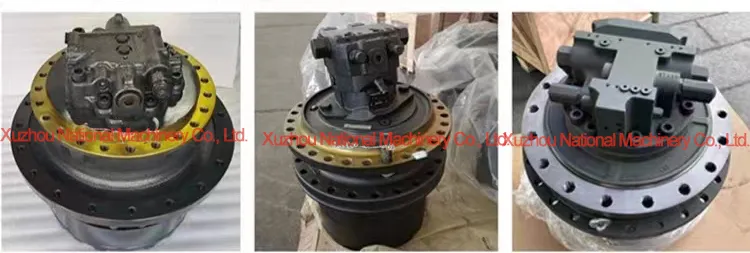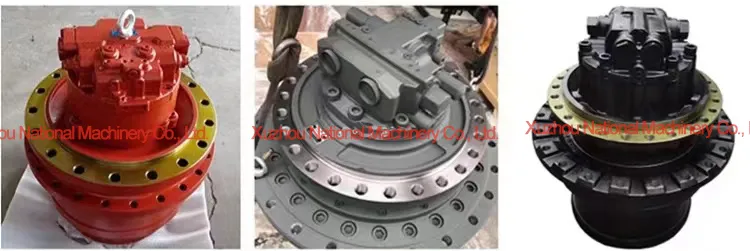
Mini excavators are essential tools in construction, landscaping, and various other industries. One of the critical components of these machines is the final drive motor, which powers the movement of the tracks and ultimately determines the mobility and efficiency of the excavator. Diagnosing problems with the excavator final drive motor early can save you time, money, and prevent potential downtime.
Recognizing the early signs of a bad final drive is crucial for preventing further damage and ensuring the smooth operation of your mini excavator. Here are some telltale signs that your final drive might be failing:
If you hear grinding, clicking, or knocking noises coming from the final drive, it’s a strong indicator that there may be internal damage. These sounds often suggest issues with the gears, bearings, or other internal components that are not functioning correctly.
A noticeable drop in the excavator’s performance, such as sluggish movement or difficulty climbing slopes, could indicate a problem with the final drive. Reduced power often points to hydraulic issues or wear and tear on the drive’s internal mechanisms.

Oil leaks around the final drive are a clear sign that something is wrong. Leaks can occur due to damaged seals, cracks in the housing, or other internal failures. If you notice oil pooling under the excavator or on the drive itself, immediate inspection and repair are necessary.
Final drives that overheat during operation can signal a serious problem. Overheating might be caused by insufficient lubrication, excessive load, or internal friction. Continuous overheating can lead to severe damage and potentially complete failure of the final drive.
Excessive vibration or wobbling when the excavator is in motion can indicate misalignment, damaged bearings, or other internal issues within the final drive. Consistent vibration should not be ignored as it can exacerbate wear and lead to more significant problems.
Troubleshooting final drive issues involves systematic inspection and testing to pinpoint the exact problem. Here’s a step-by-step approach to diagnosing and resolving common final drive issues:
Begin with a thorough visual inspection of the final drive. Look for any visible damage, oil leaks, or loose components. Pay close attention to the condition of the seals, bolts, and the overall housing of the final drive.
Ensure that the oil levels in the final drive are adequate. Low oil levels can cause overheating and insufficient lubrication, leading to accelerated wear. If the oil level is low, inspect for leaks and refill with the manufacturer-recommended oil.
Operate the excavator and listen for any unusual noises emanating from the final drive. Grinding or clicking sounds can indicate issues with the gears or bearings. Note the type of noise and its frequency to help identify the specific problem.
Using a hydraulic pressure gauge, test the pressure levels in the final drive. Low hydraulic pressure can affect the performance and may point to issues with the hydraulic motor or internal components. Compare the readings with the manufacturer’s specifications.
Disassemble the final drive if necessary to inspect the condition of the bearings and gears. Look for signs of wear, pitting, or damage. Replace any worn or damaged parts to restore the final drive’s functionality.
Contaminants in the hydraulic oil can cause significant damage to the final drive. Inspect the oil for any signs of metal particles, dirt, or water. If contamination is found, flush the system and replace the oil and filters.

Overheating is one of the most serious issues that can affect a final drive. It can lead to catastrophic failure if not addressed promptly. Here are some common causes of overheating and how to prevent them:
Ensure that the final drive is always adequately lubricated. Regularly check oil levels and top up as needed. Use only the recommended type of oil to maintain optimal performance.
Avoid overloading the excavator beyond its rated capacity. Excessive load can increase the stress on the final drive, causing it to overheat. Follow the manufacturer’s guidelines for operating load limits.
Regular maintenance is crucial for preventing overheating. This includes checking and replacing oil, inspecting seals and bearings, and cleaning the final drive components. A well-maintained final drive is less likely to overheat.
Operating in extremely high ambient temperatures can contribute to overheating. If possible, schedule heavy-duty operations during cooler parts of the day and ensure that the excavator has adequate cooling measures in place.
Check the hydraulic system for any issues that might contribute to overheating, such as blocked filters or low hydraulic fluid levels. Ensure that the hydraulic system is functioning correctly to prevent additional strain on the final drive.
Noise and vibration are often early indicators of problems within the final drive. Here’s how to diagnose and address these issues:
Regularly monitor the excavator during operation for any changes in noise or vibration. Early detection can prevent minor issues from becoming major problems.
Leakage is a critical issue that can lead to significant damage if not addressed promptly. Here’s how to identify and fix leaks:
Regularly inspect the final drive for any signs of oil leaks. Look for oil spots on the ground or oil dripping from the drive.
Seals are often the source of leaks. Check the condition of the seals and replace them if they are worn or damaged. Ensure that seals are properly installed and seated.
Inspect the housing of the final drive for cracks or damage. Any damage to the housing can lead to leaks and should be repaired or replaced immediately.
Perform regular maintenance to ensure that all components are in good condition and that the final drive is adequately lubricated. Regular maintenance can help prevent leaks and extend the life of the final drive.
The cover plate of the final drive protects the internal components from dirt, debris, and other contaminants. A missing or damaged cover plate can lead to serious issues:
Regularly inspect the cover plate for any signs of damage or wear. Replace the cover plate if it is missing or damaged to protect the final drive.
Ensure that the cover plate is properly fitted and secured. A loose or improperly fitted cover plate can allow contaminants to enter the final drive.
Clean the cover plate and the surrounding area regularly to prevent the build-up of dirt and debris. Keeping the cover plate clean can help maintain the performance and longevity of the final drive.
Creating a maintenance plan is essential for preserving the performance and longevity of your mini excavator’s final drive. Here are some steps to include in your plan:
Schedule regular inspections to identify and address any issues early. Inspections should include checking for leaks, inspecting seals and bearings, and monitoring noise and vibration levels.
Create a maintenance schedule that includes regular oil changes, seal replacements, and component inspections. Follow the manufacturer’s guidelines for maintenance intervals.
Ensure that operators are trained to recognize the signs of final drive issues and know how to perform basic maintenance tasks. Proper operation and maintenance can prevent many common issues.
Keep detailed records of all maintenance and repairs. This can help you track the performance of the final drive and identify patterns or recurring issues.
Implementing a daily routine can help ensure that your final drive remains in good condition and operates efficiently. Here’s a suggested routine:
Proper maintenance and early diagnosis of final
drive issues are crucial for the efficient operation and longevity of your mini excavator. By understanding the signs of a failing final drive, troubleshooting common problems, and implementing regular maintenance routines, you can prevent significant damage and ensure that your equipment remains in top condition. Remember to keep detailed records of all maintenance and repairs, and ensure that operators are trained to recognize and address potential issues.
The first signs of a faulty track drive typically include unusual noises such as grinding or knocking, reduced power during operation, and visible oil leaks around the final drive.
The track drive should be inspected regularly, with visual checks every 250 hours of operation and more detailed inspections, including oil analysis and hydraulic pressure tests, every 1,000 hours.
Depending on the severity of the damage, a faulty track drive can sometimes be repaired by replacing worn components such as gears and bearings. However, severe damage may require a complete replacement of the final drive.
The best type of lubrication for final drives is typically a high-quality gear oil that meets the manufacturer’s specifications. This oil should have the appropriate viscosity and contain additives that protect against wear, corrosion, and extreme pressure.
To improve the longevity of your travel motor, perform regular maintenance checks, use the recommended hydraulic fluid, ensure proper filtration to keep the fluid clean, and address any leaks or unusual noises promptly. Additionally, operating the excavator within its designed parameters and avoiding excessive loads can help reduce stress on the travel motor.